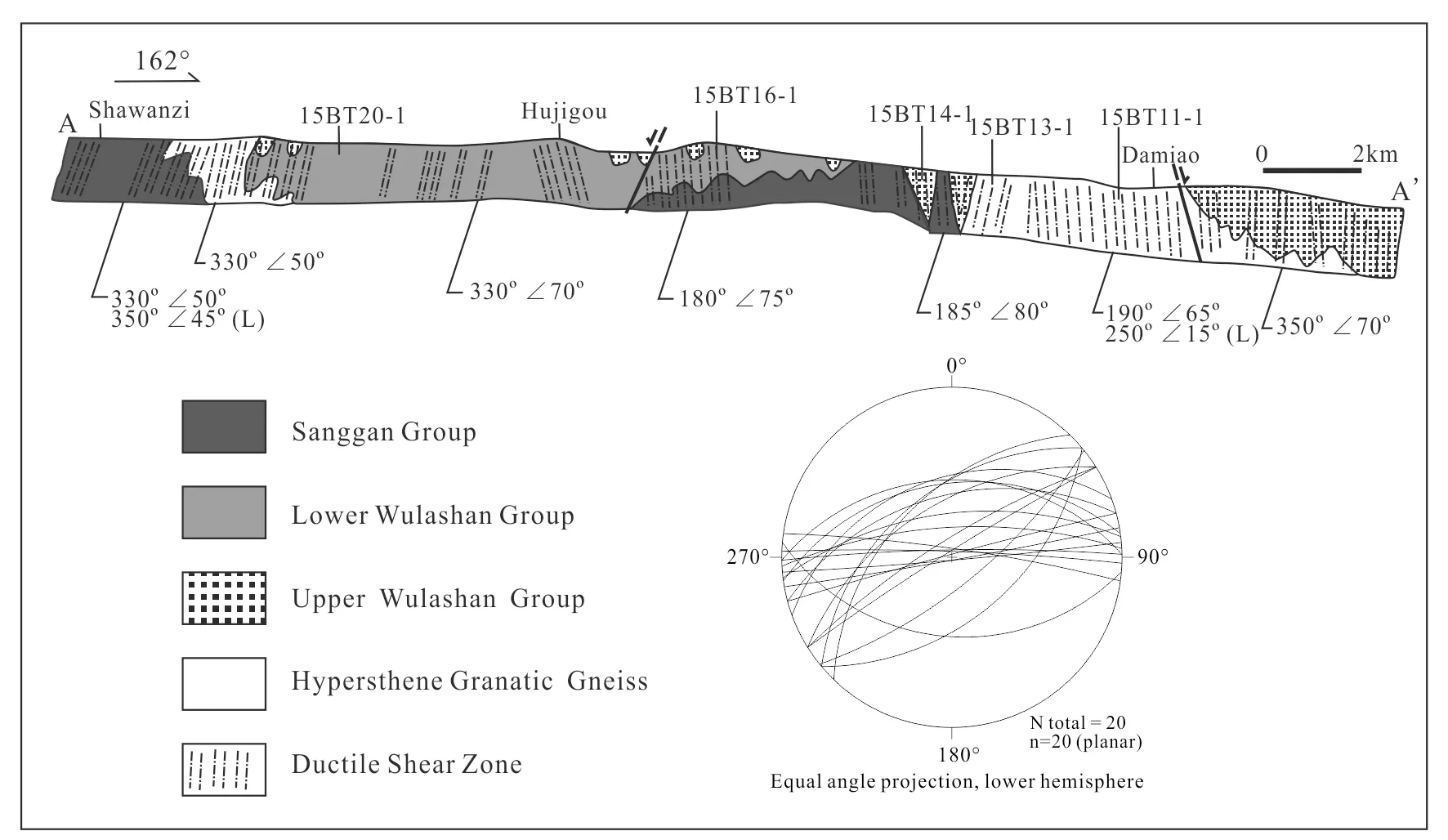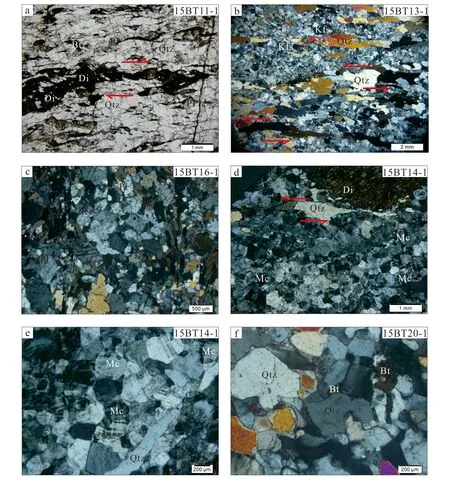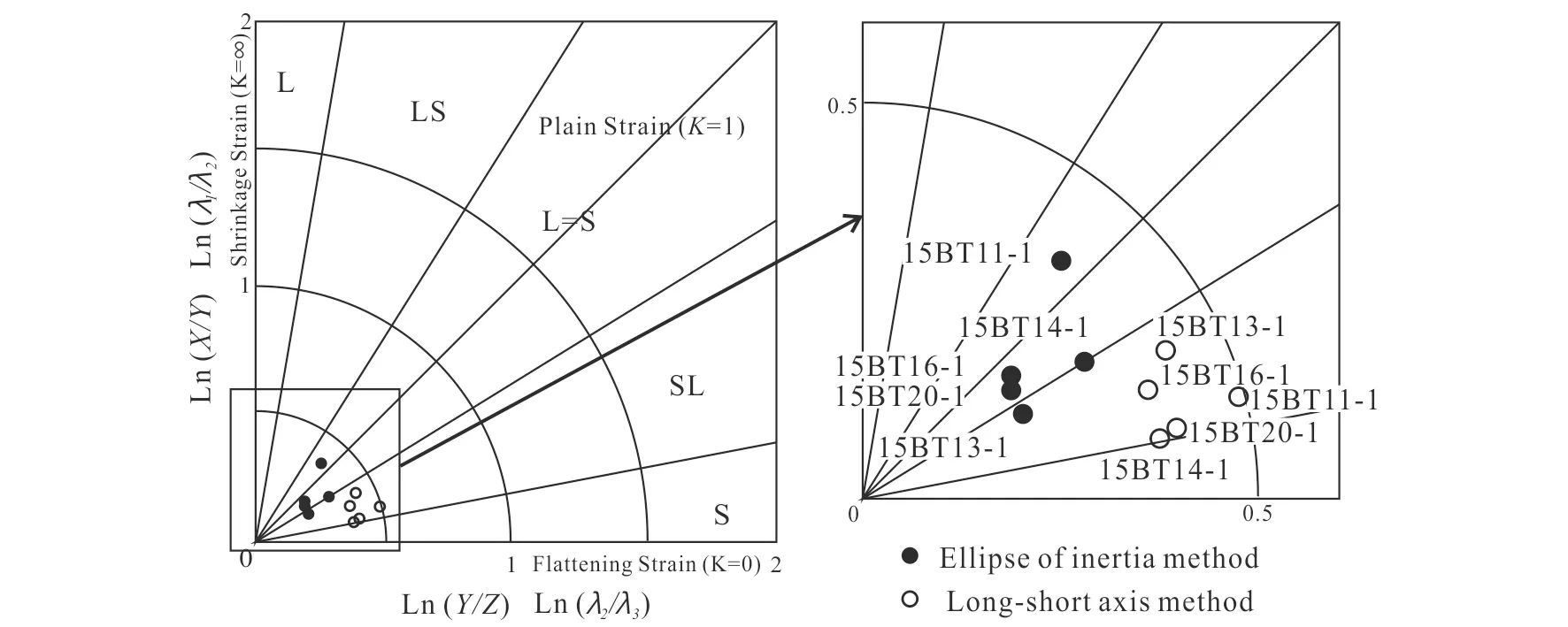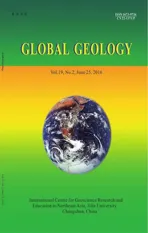Genesis of lower strain S-L-type tectonites in Daqingshan area, Inner Mongolia
2016-07-16SHAOYilunLIUYongjiangJIAJieLIWeiminandJINWei
SHAO Yilun, LIU Yongjiang*, JIA Jie, LI Weiminand JIN Wei
1.CollegeofEarthSciences,JilinUniversity,Changchun130061,China;2.China-JapanUnionHospitalofJilinUniversity,Changchun130033,China
Genesis of lower strain S-L-type tectonites in Daqingshan area, Inner Mongolia
SHAO Yilun1, LIU Yongjiang1*, JIA Jie2, LI Weimin1and JIN Wei1
1.CollegeofEarthSciences,JilinUniversity,Changchun130061,China;2.China-JapanUnionHospitalofJilinUniversity,Changchun130033,China
Abstract:Usual ductile shear zone has relatively high strain magnitude. However, for high-grade metamorphic rocks in Daqingshan area, the related strain is very low with weakly developed lineation. Significantly, the finite strain type with a K-value slightly lower than 1 and is characterized by compressional strain. Because the special tectonic environment with high temperature, the percentage of melt is relatively higher, which leads to a series of microscopic phenomenon such as multi-grain quartz bands, feldspar three edges equilibrium-like texture, granular flow, etc. As a consequence, the tectonites in the studied area illustrate a unique character: obvious rheological meso-deformation structure but with very weak intracrystalline micro-deformation.
Key words:Daqingshan area; high-grade metamorphic rocks; deformation; strain; partial melting
1Introduction
It has been a long time that Daqingshan area is a hot point for geologists (Jinetal., 1991, 1992; Liuetal., 1993; Jin & Li, 1996; Yangetal., 2000, 2003; Xuetal., 2001, 2002, 2005, 2007; Liuetal., 2007, 2011; Chenetal., 2008; Liangetal., 2008; Zhai & Santosh, 2011; Dongetal., 2012; Maetal., 2012, 2015). The metamorphic process related to the Early Precambrian collision of the Yinshan Block and Ordos Block has both anticlockwise isobaric cooling (IBC) P-T-t path and clockwise isothermal decompression (ITD) P-T-t path, which reflects the lower cooling rate of the lower crust (<0. 3℃/Ma) (Jinetal., 1991, 1992; Liuetal., 1993; Jin & Li, 1996; Zhaoetal., 2005). As more and more geochronological methods have been used, a series of the tectono-thermal event ages were obtained (Yangetal., 2000, 2003; Xuetal., 2002, 2005; Wanetal., 2009; Maetal., 2012; Dongetal., 2012; Maetal., 2015). For structural and ductile shear zone research, there are also a lot of previous works showing the positive guidance (Song & Xu, 2003; Xuetal., 2005; Chenetal., 2008; Liangetal., 2008; Liuetal., 2011; Gongetal., 2014). In this paper, we have collected five samples along Damiao-Hujigou-Shawanzi cross-section (Fig.1), in which the tectonic gneisses are well outcropped. The finite strain results from diffe-rent methods also illustrated special characters that do not show high strain magnitude as some other similar researches (Mengetal., 2013; Luoetal., 2014; Liangetal., 2015a,b). So, the main purpose of this study is to describe the deformation behavior and it’s finite strain types when more melts are involved during the deformation.
2Geological settings
Daqingshan area is located in central Inner Mongolia, which belongs to Khondalite Belt between Yin-shan Block and Ordos Block (Fig.1) (Zhaoetal., 2005; Zhai & Santosh, 2011). Generally, the typical supracrustal rocks are divided into three groups: the Sanggan Group (previously named Xinghe Group, including melanocratic and mesocratic granulite), Lower Wulashan Group (melanocratic and leucocratic gneiss) and Upper Wulashan Group (khondalite) (Yangetal., 2000, 2003). The previous studies believed that these three groups were all formed in the Archean (Yangetal., 2000, 2003; Xuetal., 2002, 2005). However, recent research indicated that only the Sanggan Group was formed during the Late Neoarchean, while the Lower Wulashan Group was formed from the Late Neoarchean to Early Paleoproterozoic and the Upper Wulashan Group was generated during the Late Paleoproterozoic (Wanetal., 2009; Maetal., 2012; Dongetal., 2012). At the macroscopic level, there were developed nearly E-W trending steeply dipping foliation belts with a series of folds (Fig.2, Xuetal., 2001; Song & Xu, 2003; Xuetal., 2007; Chenetal., 2008).
3Mesostructural and microstructural characters
Along the Damiao-Hujigou-Shawanzi section, we collected a lot of structral data in detail, the foliation dip directions range 314°--8° and 140°--185° with the dip angle of ca. 40°--88°, while the lineation is undeveloped (Figs.2,3). Most granulites, gneisses and mylonites were usually modified by the strong rheological processes. The studied area is dominated by the sinistral ductile shear zone (Fig.3e,f). Besides, there are also many folds formed by strong compression (Fig.3b,c). Along the Damiao-Hujigou-Shawanzi cross-section, we have collected 5 samples to do the further intensive studies (Figs.1, 2, Table 1).

Fig.2 Cross section in Daqingshan area (modified after Xu et al., 2007) and Schmidt projection of lower hemisphere for foliations

(a) Subvertical granitic gneiss; (b) compression deformation zone; (c) fold with partial melting feature; (d) subvertical foliation; (e) ductile sinistral shearing; (f) K-feldspar porphyroclast indicate sinistral shear sense.Fig.3 Some representative mesofabrics of Daqingshan area
According to microfabrics, most samples in research area are named gneiss (Table 1). They consist mainly of quartz and feldspar, with minor amounts of diopside, biotite and garnet. Meanwhile, numerous significant microstructures and texture could be seen. The pyroxene chains and multi-grain quartz bands are often generated within high P-T condition (Fig.4a, b). Generally, the thin sections of all samples de-monstrate sinistral shearing except sample 15BT11-1 (Fig.4a,b,d). These microstructures of quartz grains indicate dynamic recrystallization by GBM (grain boundary migration) and static recrystallization, partly show obvious subgrain rotation recrystallization (SGR) (Fig.4c-f). These microstructural features constrain that the deformation temperature was high.

Table 1 Features of samples in ductile shear zone along Hujigou-Damiao-Shawanzi cross section
Abbreviations: Bt: biotite; Di: diopside; Kfs:K-feldspar; Mc: microcline; Pl: plagioclase; Qtz: quartz; (R) stands for reverse.

(a) Pyroxene chains show a dextral shear sense; (b) multi-grain quartz ribbons suggest a sinistral shearing; (c) quartz grains have grain boundary slide fabric; (d) sinistral quartz fish fabric and subgrain rotation (SGR) indicate sinistral shearing; (e) microclines with three edges equilibrium-like texture; (f) quartz window texture (GBM). Bt: biotite; Di: diopside; Kfs: K-feldspar; Mc: microcline; Pl: plagioclase; Qtz: quartz. Micrograph a was taken with single polarizer, b-f were taken with crossed polarizers.Fig.4 Microscopic deformation characteristics in Daqingshan area
4Finite strain measurements
Regarding to the strain measurements, a lot of methods can be chosen such as Fry’s, long-short axis, ellipse of inertia, Rf/φ, Elliott’s, neighbor center-to-center method, etc (Ramsay, 1967; Elliott, 1970; Fry, 1979; Ramsay & Huber, 1983; Zheng & Chang, 1985; Wangetal., 2004). In this paper, we selected ellipse of inertia and long-short axis methods.
Initially, according to the direction of stretching lineation and foliation (i.e.XZandYZplains), two oriented thin sections were prepared and microphotographs were taken under microscope. Then, the strain measurements have been done on thin sections separately. Usually quartz and feldspar are the ideal strain markers (Zheng & Chang, 1985; Wangetal., 2001; Wangetal., 2004). In our study, since feldspar grains are well shown in the thin section, the feldspars exist in high-grade metamorphic environment that are helpful to show the deformation features, so we choose the feldspar for finite strain measurement. The reason why we abandon Fry’s method is that the feldspar grains we selected might reveal Poisson distribution, which would lead to big errors (Zheng & Chang, 1985; Li & Wang, 2001).
We selected five samples with well developed foliations, each oriental sample has two plains (X/ZandY/Z), 40--60 feldspar grains in the each plain are chosen under microphotographs, then use Straindesk software to calculate the Flinn parameterKvalue (K=ln(X/Y)/ln(Y/Z)) by using different methods mentioned above (Li & Zeng, 2006; Ramsay, 1967; Ramsay & Huber, 1983).
The results are given in Table 2 and graphically shown in Fig.5. By the differentKvalue, Flinn finite strain diagram could be divided into 5 zones: axisymmetric compression (K=0--0.15), normal compression (K=0.15--0.67), plain strain (K=0.67--1.5), normal extension (K=1.5--6.67) and axisymmetric extension (K=6.67--+∞) (Zheng & Chang, 1985). All these data of the long-short axis method are plotted into normal compression zone while the ellipse of inertia method’s data are plotted both normal compression and plain strain zone. Overall, the gneisses are all of S-L-type tectonites suggest compression works on these Precambrian basements (Figs.3a,d,5).

Fig.5 Flinn finite strain discrimination diagram

SampleLithologyEllipseofinertiamethodX/YY/ZX/ZKLong-shortaxismethodX/YY/ZX/ZK15BT11--1Graniticgneiss1.3521.2841.7361.2071.1431.6121.8430.28015BT13--1Myloniticfelsicgneiss1.1871.3231.5700.6121.2081.4681.7740.49315BT14--1Graniticgneiss1.1111.2211.3560.5251.0611.4571.5460.15815BT16--1Graniticgneiss1.1511.2031.3850.7621.1391.4351.6350.36115BT20--1Felsicgneiss1.1451.2011.3750.7391.0851.4861.6130.207
An interesting point is that the long-short axis method gives a lower value of ln(X/Y) and a higher value of ln(Y/Z) than the ellipse of inertia method. Furthermore, the long-short axis method’s data tends to concentrate while the ellipse of inertia method tends to disperse. The difference between two methods is probably ascribed to their own theories. According to the ellipse of inertia, the followers illustrated that the representative deformation features could be shown even if the lack of measurable grains (Li & Zeng, 2006; Lietal., 2008). Moreover, the scatter of selected grains’ position and the arbitrary shape would not influence the accuracy. Nevertheless, the application of this method is not so widely (Wuetal., 2012; Heetal., 2014; Xueetal., 2014). So this method’s effectiveness needs more inspections. Relatively, the long-short axis method has enjoyed more popular supports (Ramsay, 1967; Zheng & Chang, 1985; Wangetal., 2004; Liangetal., 2015a,b). However, the grain shape (especially for flattened grains) would affect the accuracy of data (Zheng & Chang, 1985). Probably these factors are the essential reason why theX/Zvalue by the long-short axis method is obviously higher than previous one.
Another interesting appearance is that the strain magnitude (ln(X/Y) and ln(Y/Z)) is universally low (less than 0.5), which is different from that in the representative shear zones (Mengetal., 2013; Luoetal., 2014; Liangetal., 2015a,b). These differences will be discussed in the following text.
5Discussions
Related researches on ductile shear zones in the area have been gotten many progresses, however, most researhers pay attention to the deformation in the upper crusts (Luoetal., 2014; Xueetal., 2014; Liangetal., 2015a,b), which deformation temperature mainly ranges from 300--500°C. Chenetal., (2008) indicated that the average temperature and pressure of the metamorphic rocks in the Daqingshan area are about 710°C, 0.6 Gpa. Under microstruc-tural observation, felsic grain recrystallization type (SGR for feldspar, GBM for quartz) also coincides with the metamorphic temperature (Fig.4d-f) (Passchier & Trouw, 2005). Furthermore, since the low strain due to high-grade metamorphic process, some research methods could not be used for this case study (Passchier, 1988; Takahashietal., 1998; Passchier & Trouw, 2005; Mamtani, 2010).
For rock plastic deformation, there are two cru-cial mechanisms: solid rock and partial melted rock’s plastic flow deformation (Yangetal., 2008). Paterson (2001) indicated that plastic flowing is based on several factors: dislocation creep, diffusion creep and granular flow (or switching). For partial melted one, though similar process will happen in macroscopic, by micro-view, much less visible deformation fabrics could be seen, and static crystallization-like three edges equilibrium texture is popular (Fig.4e) (Rutter & Neumann, 1995; Petford & Koenders, 1998; Paterson, 2001; Yangetal., 2008).
The previous researches in the Daqingshan area show that the high-grade metamorphic rocks experienced anataxis and partial melting (Song & Xu, 2003; Chenetal., 2008; Liangetal., 2008; Liuetal., 2007, 2011). Under microscope observation, multi-grain quartz bands and feldspar three edges equilibrium-like texture are generally seen (Fig.4b,e). On the other hand, Walteetal. (2005) estimated partial melting degree by observing grain deformation features (e.g. granular flow, grain boundary slide, etc.). Follow this method, we infer the melt percentage in the studied area ranges in 8--30%. As a result, in the outcrops the flowing structure influenced by the melt could be seen easily, but deformation fabrics are hardly observed under microscope. For samples with higher percentage melt, granular flow is the main deformation mechanism (Fig.4b,d); while for samples with lower percentage melt, grains tend to be influenced by dynamic recrystallization or grain boundary slide (Fig.4c,f). These discoveries coincide with some previous researches (Walteetal., 2005; Liuetal., 2007, 2011). Due to the more and more melt involved, the strain is relatively low in this case study. Meanwhile, samples in the studied area also reveal a few low-grade metamorphic characters, probably due to the subsequent crust uplift with retrograde alteration.
6Conclusions
(1) Outcrop-scale structural features clearly indicate rheological textures, while microfabrics show weak mineral grain deformation with obvious granular flow characters.
(2) The deformed rocks with high-grade metamorphism in the studied area shows plain compression (S-L-type tectonite) with low strain, which probably represent the rheological features of the lower crust.
(3) The finite strain measurements with lower strain is probably due to partial melting process with higher percentage of melt.
References
Chen X F, Liu Z H, Xu Z Y,etal. 2008. The characters and genesis of the lower crust Daqingshan ductile shear zones in the Inner Mongolia.JournalofMineralogyandPetrology, 28(1): 48-53. (in Chinese with English abstract)
Dong C Y, Wan Y S, Xu Z Y,etal. 2012. SHRIMP zircon U-Pb dating of Late Paleoproterozoic kondalites in the Daqing Mountains area on the North China Craton.ScienceChinaEarthSciences, 56(1): 115-125.
Elliott D. 1970. Determination of finite strain and initial shape from deformed elliptical objects.GeologicalSocietyofAmericaBulletin, 81(8): 2221-2236.
Fry N. 1979. Random point distributions and strain measurement in rocks.Tectonophysics, 60(1): 89-105.
Gong W B, Hu J M, Wu S J,etal. 2014. Possible southwestward extrusion of the Ordos Block in the Late Paleopro-terozoic: constraints from kinematic and geochronologic analysis of peripheral ductile shear zones.PrecambrianResearch, 255: 716-733.
He G J, Jin W, Hu W Z. 2014. Kinematic vorticity and its application to the Yanlinsi ductile shear zone in eastern Hunan Province.GeologicalSurveyandresearch, 2: 136-143. (in Chinese with English abstract)
Jin W, Li S X. 1996. PTt path and crustal thermodynamic model of late Archean-Early Proterozoic high grade me-tamorphic terrain in North China.ActaPetrologicaSinica, 12(2): 42-55. (in Chinese with English abstract)
Jin W, Li S X, Liu X S. 1991. A study on characteristics of early Precambrian high-grade metamorphic rock series and their metamorphic dynamics.ActaPetrologicaSinica, 4: 27-35. (in Chinese with English abstract)
Jin W, Li S X, Liu X S. 1992. Early Precambrian metamorphic rocks and early earth crust evolution in Daqingshan, Inner Mongolia.JournalofChangchunUniversityofEarthSciences, 22(3): 281-289. (in Chinese with English abstract)
Li D L, Wang E L. 2001. Structural Geology. Changchun: Jilin University Press, 1-203. (in Chinese)
Li Z Y, Zeng Z X. 2006. Finite strain measurement of rocks by using of inertia moment ellipses.GeologicalScienceandTechnologyInformation, 25(6): 37-40. (in Chinese with English abstract)
Li Z Y, Zeng Z X, Luo W Q. 2008. First approach to the significance of inertia moment projection ellipsoid for structure deformation analysis.GeologicalReview, 54(2): 243-252. (in Chinese with English abstract)
Liang C Y, Liu Y J, Meng J Y,etal. 2015a. Strain and fractal analysis of dynamically recrystallized quartz grains and rheological parameter estimation of Shulan ductile shear zone.EarthScience-JournalofChinaUniversityofGeosciences, 40(1): 115-129. (in Chinese with English abstract)
Liang C Y, Liu Y J, Neubauer F,etal. 2015b. Structures, kinematic analysis, rheological parameters and temperature-pressure estimate of the Mesozoic Xingcheng-Taili ductile shear zone in the North China Craton.JournalofStructuralGeology, 78: 27-51.
Liang Y H, Liu Z H, Fan H Z. 2008. The horizontal bedding extensional deformation in the Archean high-grade metamorphic rocks from Daqingshan region.JournalofJilinUniversity:EarthScienceEdition, 38(3): 368-375. (in Chinese with English abstract)
Liu X S, Jin W, Li S X,etal. 1993. Two types of Precambrian high‐grade metamorphism, Inner Mongolia, China.JournalofMetamorphicGeology, 11(4): 499-510. (in Chinese with English abstract)
Liu Z H, Xu Z Y and Wang K Y. 2007. Evidence of microstructures and fluid inclusions for the origin of polycrystalline quartz ribbons in high-grade metamorphic rocks in Daqingshan region.ScienceinChinaSeriesD:EarthSciences, 50(4): 496-504.
Liu Z H, Li S C, Xu Z Y,etal. 2011. Characteristics of melt lineation of high-grade metamorphic rocks at Daqingshan region of Inner Mongolia.EarthScienceFrontiers, 18(2): 055-061. (in Chinese with English abstract)
Luo W, Liu Y J, Fang B W,etal. 2014. Genesis analysis of augen texture in mylonite of ductile shear zone of Taili in western Liaoning.GlobalGeology, 33(4): 844-854. (in Chinese with English abstract)
Ma M Z, Wan Y S, Santosh M,etal. 2012. Decoding multiple tectonothermal events in zircons from single rock samples: SHRIMP zircon U-Pb data from the late Neoarchean rocks of Daqingshan, North China Craton.GondwanaResearch, 22(3/4): 810-827.
Ma M Z, Dong C Y, Xu Z Y,etal. 2015. Anatexis of Early Paleoproterozoic garnet-biotite gneisses (Daqingshan supracrustal rocks) in Daqingshan, Inner Mongolia: Geology, zircon geochronology and geochemistry.ActaPetrolo-gicaSinica. 31(6): 1535-1548. (in Chinese with English abstract)
Mamtani M A. 2010. Strain-rate estimation using fractal analysis of quartz grains in naturally deformed rocks.JournaloftheGeologicalSocietyofIndia, 75(1): 202-209.
Meng J Y, Liu Y J, Liang C Y,etal. 2013. Characteristics of ductile deformation of Jiamusi-Yitong fault.GlobalGeology, 32(4): 800-807. (in Chinese with English abstract)
Passchier C W. 1988. The use of Mohr circles to describe non-coaxial progressive deformation.Tectonophysics, 149(3): 323-338.
Passchier C W, Trouw R A J. 2005. Microtectonics. 2nd. Berlin: Springer-Verlag, 1-306.
Paterson M S. 2001. A granular flow theory for the deformation of partially molten rock.Tectonophysics, 335: 51-61.
Petford N, Koenders M A. 1998. Granular flow and viscous fluctuations in low Bagnold number granitic magmas.JournaloftheGeologicalSociety, 155(5): 873-881.
Ramsay J G. 1967. Folding and fracturing of rocks. New York: McGraw-Hill Companies, 1-568.
Ramsay J G, Huber M I. 1983. The techniques of modern structural geology. Vol.1: strain analysis. London: Academic Press, 1-307.
Rutter E H, Neumann D HK. 1995. Experimental deformation of partially molten Westerly granite under fluid-absent conditions, with implications for the extraction of granitic magmas.JournalofGeophysicalResearch:SolidEarth(1978-2012), 100(B8): 15697-15715.
Song H L, Xu Z Y. 2003. Sub-horizontal shearing structures and anatexis of Archean lower crustal rocks in Daqingshan area, Inner Mongolia.GlobalGeology, 22(1): 30-35. (in Chinese with English abstract)
Takahashi M, Nagahama H, Masuda T,etal. 1998. Fractal analysis of experimentally, dynamically recrystallized quartz grains and its possible application as a strain rate meter.JournalofStructuralGeology, 20(2/3): 269-275.
Walte N P, Bons P D, Passchier C W. 2005. Deformation of melt-bearing systems-insight from in situ grain-scale analogue experiments.JournalofStructuralGeology, 27(9): 1666-1679.
Wan Y S, Liu D Y, Dong C Y,etal. 2009. The Precambrian Khondalite Belt in the Daqingshan area, North China Craton:evidence for multiple metamorphic events in the Palaeoproterozoic era.Geologicalsociety,London,SpecialPublications. 323(1): 73-97. (in Chinese with English abstract)
Wan Y S, Xu Z Y, Dong C Y,etal. 2013. Episodic Paleoproterozoic (~2.45, ~1.95 and ~1.85 Ga) mafic magmatism and associated high temperature metamorphism in the Daqingshan area, North China Craton: SHRIMP zircon U-Pb dating and whole-rock geochemistry.PrecambrianResearch, 224: 71-93.
Wang Y B, Liang M H, Huo Q Z,etal. 2004. The study of the limit deformation measurement with deformation feldspar in granite areas.NorthwesternGeology, 34(1): 19-24. (in Chinese with English abstract)
Wang X S, Zheng Y D, Yang C H,etal. 2001. Determination of the deformation temperature and strain rate by the fractal shape of dynamically recrystallized quratz grains.ActaPetrologicaetMineralogica, 20(1): 36-41. (in Chinese with English abstract)
Wu L B, Zeng Z X, Gao X,etal. 2012. Strain measurement and analysis of matrix of trapezoidal boudinage in Tieshan, southeast Hubei, China.Geoscience, 26(2), 294-307. (in Chinese with English abstract)
Xu Z Y, Liu Z H, Yang Z S. 2001. The Composition and Characteristics of the Early Precambrian Metamorphic Strata in Daqingshan Region, Inner Mongolia.GlobalGeology, 20(3): 209-218. (in Chinese with English abstract)
Xu Z Y, Liu Z H, Yang Z S. 2002. The strata texture of khondalite in Daqingshan area, Inner Mongolia.JournalofJilinUniversity:EarthScienceEdition, 4: 313-318. (in Chinese with English abstract)
Xu Z Y, Liu Z H, Yang Z S. 2005. Structures of early metamorphic strata in the khondalite series in the Daqingshan-Wulashan area, Inner Mongolia: Results of the sub-horizontal bedding-parallel detachment deformation in the lower crust.JournalofStratigraphy, 29(S1): 423-432. (in Chinese with English abstract)
Xu Z Y, Liu Z H, Yang Z S,etal. 2007. Structure of metamorphic strata of the khondalite series in the Daqingshan-Wulashan area, central Inner Mongolia, China, and their geodynamic implications.GeologicalBulletinofChina, 26(5): 526-536. (in Chinese with English abstract)
Xue D J, Xu X B, Li Y,etal. 2014. Structural characteristics and deformation mechanism of Early Paleozoic granite in the Wugongshan area, south China.ActaGeologicaSinica, 88(7): 1236-1246. (in Chinese with English abstract)
Yang Z S, Xu Z Y, Liu Z H. 2000. Khondalite event and Archean crust structure evolution.ProgressinPrecambrianResearch, 23(4): 211-260. (in Chinese with English abstract)
Yang Z S, Xu Z Y, Liu Z H,etal. 2003. Consideration and practice of the construction of litho stratigraphic systems in high-grade metamorphic terrains-A case study in the Daqingshan-Wulashan area.ChineseGeology, 30(4): 343-351. (in Chinese with English abstract)
Yang Z S, Xu Z Y, Liu Z H,etal. 2008. Geological investigation and research on high-grade metamorphic regions. Beijing: Geological Publication House, 1-276. (in Chinese)
Zhai M G, Santosh M. 2011. The early Precambrian odyssey of the North China Craton: A synoptic overview.GondwanaResearch, 20(1): 6-25.
Zhao G C, Sun M, Wilde S A,etal. 2005. Late Archean to Paleoproterozoic evolution of the North China Craton: key issues revisited.PrecambrianResearch, 136(2): 177-202.
Zheng Y D, Chang Z Z. 1985 Finite strain measurement and ductile shear zones. Beijing: Geological Publishing House, 35-102. (in Chinese)
doi:10.3969/j.issn.1673-9736.2016.02.02
*Corresponding author(E-mail: yongjiang@jlu.edu.cn)
Article ID: 1673-9736(2016)02-0069-09
Received 10 November 2015, accepted 11 December 2015
Supported by Project of National Natural Science Foundation of China (Nos. 41230206, 41340032)
杂志排行
Global Geology的其它文章
- Geochronology and geochemistry of Dongxigao diorite porphyries: implications for Late Neoarchean tectonic evolution of eastern North China Craton
- Petrogenesis of Paleoproterozoic diorite porphyries in Luojiazhuang, western Shandong: constraints from LA-ICP-MS zircon U-Pb geochronology and geochemistry
- Comparison of finite difference and pseudo-spectral methods in forward modelling based on metal ore model of random media
- Study of formation boundary and dip attribute extraction based on edge detection technology
- Subsurface sandstone mapping by combination of GPR and ERT method
- Rock physics and seismic modeling of shale reservoirs with horizontal fractures
